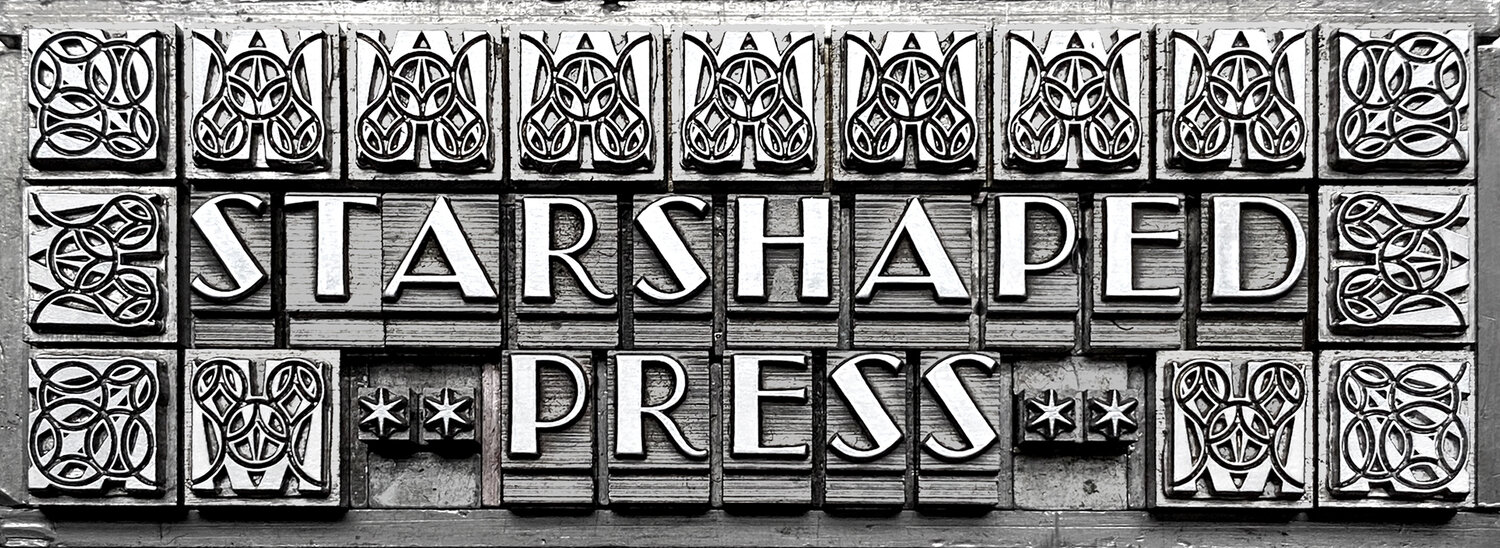This Weekend Printer is by my guest, Jessica Spring of Springtide Press. As the originator of the term ‘daredevil typesetting’ and creator of easy-to-use kits, I thought it was best to let Jessica write this blog post!
All of us letterpress printers see Starshaped Press shenanigans and wonder: is there a short cut for all this fancy typographic composition? (Is she a cyborg?!) Not really, but printer math and the right tools can be helpful in exploring what I call “daredevil typesetting.”
I began exploring some alternatives for composing type on curves and angles years ago using Plaster of Paris, foam core, moistened tissue or newsprint and plasticene. While these all can work to some degree, they can be messy, time consuming or just challenging, especially when attempting to defy gravity in a platen press.
I have had good results composing circular type using an adjustable clamp intended for plumbing by “belting” type around a roll of electrical tape. The clamps come in a huge variety of sizes, and a set of wood circles I made—lower than type high—have been useful in setting type in circles when tape rolls are just too small.
During a demonstration of printing clamped type on a platen press at a College Book Arts Association conference in 2014, I cut half-inch foam core—working around the clamp portion—to lock the clamped type in a chase. It worked, but the foam core wouldn’t hold up to multiple uses since it can be compressed, plus it’s difficult to cut.
This challenge made me wonder about creating a more stable solution. With assistance from my sister who redrew my pencil-on-graph-paper sketches, we combined laser-cut wood with plexiglas rings, similar in shape and function to the original foamcore/clamp experiment. By dumb luck, the two concentric rings had exactly 18 points of space between them: very tight, but stable with friction and tension. (I still wish brass circles were a viable option, but the expense is prohibitive.)
In designing the first set, it was important to have the material be strong, so we went with poplar. A good option for lasercutting, this utility hardwood won’t crumble like particle board can, and has the strength to maintain sharp corner cuts. I also prefer the height to be 5/8 inches to match existing furniture and provide maximum stability in surrounding type. The original set features two rings, about 3 inches, plus various angles.
The thickness of the poplar requires outsourcing the lasercutting to a local shop. My sister cuts the plexiglas rings, and the laser-cut sets are hand sanded and assembled with packaging printed at Springtide Press.
Since the original set proved helpful for composition, the next two sets I designed addressed the need for creating curves and working larger. The Double Dog set features “dumbed down” circular quads—inspired by real metal ones—which have become difficult to find in good condition anymore. If you are lucky enough to have some, Jen has provided an excellent overview and the Daredevil quads work similarly.
For working in a large cylinder press, the Big Dog set features larger quads and the plexi circles are wood instead. They measure 4, 3 and 3 picas each and can be pulled out individually to fill type in the gap, or even combined to accommodate 10 line type. Multiple sets can be combined since the original set’s circle-inside-a-square can be placed within the Big Dog set.
The basic premise to “daredevil typesetting” or any typographic composition is to build towards a rectangular form: whatever you conjure, box it in and lock it up. I also use the shapes within the sets to build forms that can be surrounded with type, ornaments or rule. These compositions then need to get boxed in again and locked up for successful printing.
While it’s possible to set just a word or phrase on a curve, circular quads and curved leads can handle lines of type and ornaments if pushed against another curved form. It’s easy to bend one or two point leads with your fingers, working slowly. Even slugs will curve, but are happier to cooperate after being warmed up a bit in your hands. Chipboard cut to the same height as leading is an excellent substitute if you don’t have leads to spare.
Tips for working with Daredevil Furniture are provided with each set, but a few reminders follow that are helpful with any sort of typographic composition:
• Use one point leading or even cover weight paper strips with metal or wood circular quads to bridge the meeting point. If wood furniture pieces aren’t fitting together nicely, try flipping some to the “wrong” side. This can help compensate for the laser cutting and make a tighter fit of pieces.
• I typically use less word spacing than in straight line composition as curves splay out the type.
• Always work on a clean stone, galley or press bed. Check to confirm the foot of each sort is touching that surface, both by finger pressure and a planer.
• Tweezers can be helpful, but stainless steel will scratch your type, so avoid the face.
Back in 2014 when I was considering whether or not to make this furniture, I took a set to Starshaped Press to get some feedback. Jen encouraged me to go for it despite my fear over launching a new product for printers, and it was very good advice. I’m grateful to her, to my sister, and to Gabby Cooksey—who likely sanded and assembled your set if you have one. I’ve sent Daredevil Furniture around the world, and even traveled with it to universities, museums, community print shops and libraries. What an absolute delight to see printers—newbies and old farts—being daredevils, using metal type in ways I never even imagined, and sharing their #daredeviltypesetting in print.
Jessica is offering free Priority shipping for US orders on all daredevil sets through the end of January, 2020. Get yours now!

















